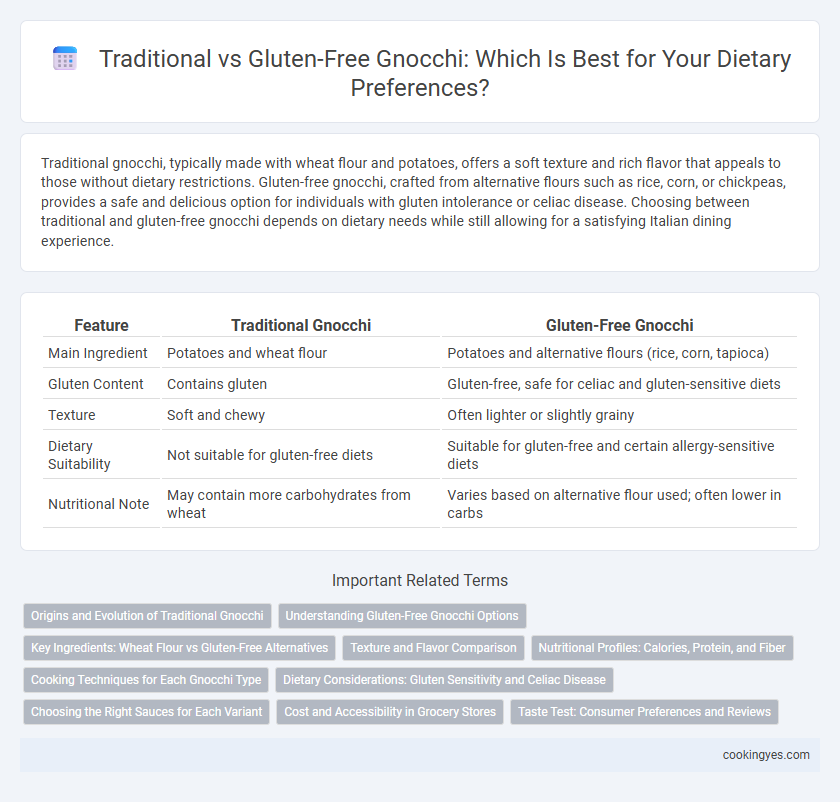Traditional gnocchi, typically made with wheat flour and potatoes, offers a soft texture and rich flavor that appeals to those without dietary restrictions. Gluten-free gnocchi, crafted from alternative flours such as rice, corn, or chickpeas, provides a safe and delicious option for individuals with gluten intolerance or celiac disease. Choosing between traditional and gluten-free gnocchi depends on dietary needs while still allowing for a satisfying Italian dining experience.
Table of Comparison
| Feature | Traditional Gnocchi | Gluten-Free Gnocchi |
|---|---|---|
| Main Ingredient | Potatoes and wheat flour | Potatoes and alternative flours (rice, corn, tapioca) |
| Gluten Content | Contains gluten | Gluten-free, safe for celiac and gluten-sensitive diets |
| Texture | Soft and chewy | Often lighter or slightly grainy |
| Dietary Suitability | Not suitable for gluten-free diets | Suitable for gluten-free and certain allergy-sensitive diets |
| Nutritional Note | May contain more carbohydrates from wheat | Varies based on alternative flour used; often lower in carbs |
Origins and Evolution of Traditional Gnocchi
Traditional gnocchi traces its origins to ancient Roman cuisine, where small dumplings made from semolina or flour were common. Over centuries, Italian families perfected recipes using potatoes, flour, and egg, creating a soft, pillowy texture that defines classic gnocchi. Gluten-free gnocchi has evolved more recently to accommodate dietary preferences, often using alternative flours like rice or chickpea to mimic the traditional dough's consistency while catering to gluten sensitivities.
Understanding Gluten-Free Gnocchi Options
Traditional gnocchi often contains wheat flour, making it unsuitable for individuals with gluten intolerance or celiac disease. Gluten-free gnocchi options use alternatives like rice flour, potato starch, or chickpea flour to provide a safe and delicious choice for gluten-sensitive diets. Understanding these gluten-free ingredients helps in selecting gnocchi that meets dietary preferences without compromising on texture or flavor.
Key Ingredients: Wheat Flour vs Gluten-Free Alternatives
Traditional gnocchi relies heavily on wheat flour, which provides a soft texture but contains gluten that can trigger sensitivities for certain individuals. Gluten-free gnocchi substitutes wheat flour with alternatives like rice flour, almond flour, or chickpea flour, catering to those with gluten intolerance or celiac disease. These gluten-free options maintain a similar consistency while aligning with specialized dietary preferences and restrictions.
Texture and Flavor Comparison
Traditional gnocchi, made from wheat flour and potatoes, offers a soft, pillowy texture with a slightly chewy bite, and a rich, comforting flavor that complements a variety of sauces. Gluten-free gnocchi, typically crafted from alternative flours such as rice or chickpea flour, tends to have a denser texture and a slightly different mouthfeel, often lighter but sometimes less elastic. Flavor profiles of gluten-free versions may vary, with subtle earthy or nutty notes depending on the flour base, providing a unique taste experience suited for those with gluten sensitivities or celiac disease.
Nutritional Profiles: Calories, Protein, and Fiber
Traditional gnocchi, typically made with wheat flour and potatoes, contains around 250 calories per serving, offering moderate protein content of approximately 5 grams and low dietary fiber of about 2 grams. Gluten-free gnocchi, often crafted from alternative flours like rice, corn, or chickpea, can vary in nutritional profiles but generally provide similar calorie counts with slightly higher protein and fiber levels due to legume-based ingredients. Consumers seeking higher fiber intake and better plant-based protein sources may prefer gluten-free gnocchi options aligned with specific dietary preferences or gluten intolerance.
Cooking Techniques for Each Gnocchi Type
Traditional gnocchi, made from wheat flour and potatoes, requires boiling in salted water until they float, indicating they are cooked through and have a tender, pillowy texture. Gluten-free gnocchi, often crafted from alternative flours like rice or chickpea, demands careful handling to prevent disintegration, with a gentler boil or pan-frying method enhancing structure and flavor. Mastering the distinct cooking temperatures and times for each gnocchi type ensures optimal texture and taste, catering to diverse dietary preferences.
Dietary Considerations: Gluten Sensitivity and Celiac Disease
Traditional gnocchi, typically made from wheat flour, contains gluten, making it unsuitable for individuals with gluten sensitivity or celiac disease. Gluten-free gnocchi options, often crafted from rice flour, potato starch, or alternative gluten-free grains, provide a safe and delicious alternative for those requiring strict gluten-free diets. Choosing gluten-free gnocchi helps prevent adverse immune reactions and intestinal damage common in celiac disease, supporting digestive health and overall well-being.
Choosing the Right Sauces for Each Variant
Traditional gnocchi, made from wheat flour, pairs well with rich, creamy sauces like Alfredo or classic tomato basil that complement its tender texture and subtly chewy bite. Gluten-free gnocchi, often crafted from rice flour, potato, or alternative grains, benefits from lighter, fresher sauces such as lemon herb or simple olive oil with garlic to enhance its delicate, slightly crumbly consistency without overpowering it. Selecting the right sauce highlights the unique characteristics of each gnocchi type, catering to specific dietary needs while maximizing flavor.
Cost and Accessibility in Grocery Stores
Traditional gnocchi, made primarily from wheat flour and potatoes, is widely available and generally more affordable in most grocery stores, making it a common choice for everyday meals. Gluten-free gnocchi, often crafted from alternative flours such as rice or corn, tends to be pricier and less accessible, typically found in specialty or health food sections. Consumers with dietary restrictions prioritize gluten-free options despite higher costs due to their necessity for maintaining gluten-free diets.
Taste Test: Consumer Preferences and Reviews
Traditional gnocchi, made with wheat flour and potatoes, offers a classic chewy texture and rich flavor favored by many consumers for its authentic Italian taste. Gluten-free gnocchi, often crafted from rice flour, cornmeal, or alternative starches, appeals to those with celiac disease or gluten sensitivity, though some reviews note a slightly grainier texture and milder taste compared to traditional versions. Consumer preference surveys show that while traditional gnocchi scores higher in flavor satisfaction, gluten-free options are increasingly praised for improved texture and versatility in specialized diets.
Traditional gnocchi vs gluten-free gnocchi for dietary preference Infographic

 cookingyes.com
cookingyes.com